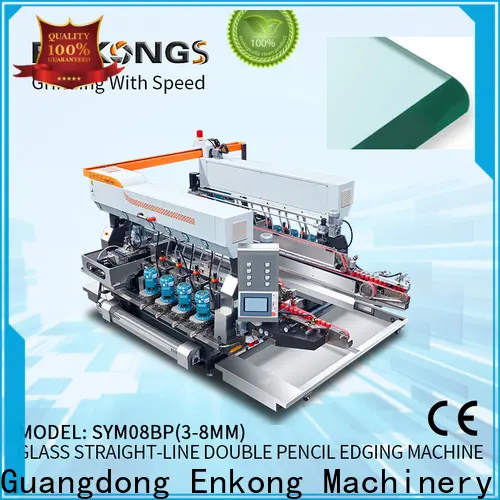Enkong Glass Machinery specialized in making high-quality glass machine, glass edging machine for global customers.
Enkong straight-line double edger machine suppliers for photovoltaic panel processing1
Brand name:
Enkong
Place of origin:
Guangdong China
Certificate:
CE/ISO(CSA UL certificate can be customized according to customer requirement for the production)
Minimum order:
1 set
Price term:
FOB/CIF/C&F(optional)
Payment terms:
L/C, T/T
Package detail:
package with film
Delivery:
20-45days
Company Advantages
1. The appearance design of Enkong double edger machine is carried out by our designers who have the ultimate pursuit of performance and aesthetics to enable the product meets the market demands. Our products are of high quality with great functions
2. The product requires a low number of workers to execute production tasks, which will help reduce labor costs and help manufacturers achieve a competitive advantage. English and Chinese instruction manual are available for our high quality glass machinery
3. The product can work with high accuracy. Its distinguished self-diagnostic feature can make sure that every motion is of high accuracy. The quality of our products can be assured by our strict QC
4. It has the proper size in consideration of the force. Each element of this product is designed with the most suitable size by considering the force acting on it and the permissible stresses for the material used. The working efficiency of our products is high
![undefined undefined]()
![undefined undefined]()
![undefined undefined]()
![undefined undefined]()
Company Features
1. Our technology takes the lead in the industry of double edger machine .
2. Sustainability engagement development is a vital part of our company operation. We engage development teams in designing more sustainable solutions across products’ life cycles, from formulation to manufacturing, to product use and end-of-life.
1. The appearance design of Enkong double edger machine is carried out by our designers who have the ultimate pursuit of performance and aesthetics to enable the product meets the market demands. Our products are of high quality with great functions
2. The product requires a low number of workers to execute production tasks, which will help reduce labor costs and help manufacturers achieve a competitive advantage. English and Chinese instruction manual are available for our high quality glass machinery
3. The product can work with high accuracy. Its distinguished self-diagnostic feature can make sure that every motion is of high accuracy. The quality of our products can be assured by our strict QC
4. It has the proper size in consideration of the force. Each element of this product is designed with the most suitable size by considering the force acting on it and the permissible stresses for the material used. The working efficiency of our products is high
/ Technical Date
SYM08 Speedy Series Technical parameter(For Photovoltaic glass )
- SYM0815/20/25/30
- 3--8mm
- 150-1700/250-2200/300-2700/300-3200mm
- 1-15m/min
- ≤0.2mm/m
- ≤0.5mm/m
- 1.5mm
- 2m/min(standard)/8m/min(Servo motor for main transmission)
- 1-20m/min
- 4200rpm
- about 25KW
- 5000/5500/6000/6500kgs
/ General description
SYM12/08 double round edging machine is directed at round edge processing.
Typical apply in household appliances and photovoltaic panel processing.
Modularise design:
Machine body and components especial stable design for low vibration processing and ensure on precision.
Company Features
1. Our technology takes the lead in the industry of double edger machine .
2. Sustainability engagement development is a vital part of our company operation. We engage development teams in designing more sustainable solutions across products’ life cycles, from formulation to manufacturing, to product use and end-of-life.
{{item.score}} Stars
{{item.pre}}%
{{item.nickname ? (item.nickname.slice(0, 2) + '*****') : item.source === 1 ? 'mall buyer' : '--'}}
{{item.comment_time}}
Review in the {{item.country}}
{{itemAttr.params_key}}: {{itemAttr.params_value}}
Contact us
we welcome custom designs and ideas and is able to cater to the specific requirements. for more information, please visit the website or contact us directly with questions or inquiries.
you might like
no data

As an innovator of glass machine, ENKONG will continue to pursue further development from a higher perspective, to set an example to the glass machine industry and build up an everlasting brand!
Professional glass processing machinery manufacturer and international glass equipment exporter.
CONTACT US
TEL : (+86)757-27756688
E-MAIL : sales@enkong.com
WHATSAPP : (+86)13724651837
OFFICE ADD :No.22, Shilong Industry Road, Lunjiao Str.,Shunde Dist., Foshan City, Guangdong, China.
E-MAIL : sales@enkong.com
WHATSAPP : (+86)13724651837
OFFICE ADD :No.22, Shilong Industry Road, Lunjiao Str.,Shunde Dist., Foshan City, Guangdong, China.
Copyright © 2025 by Guangdong Enkong Machinery Co., Ltd. |












